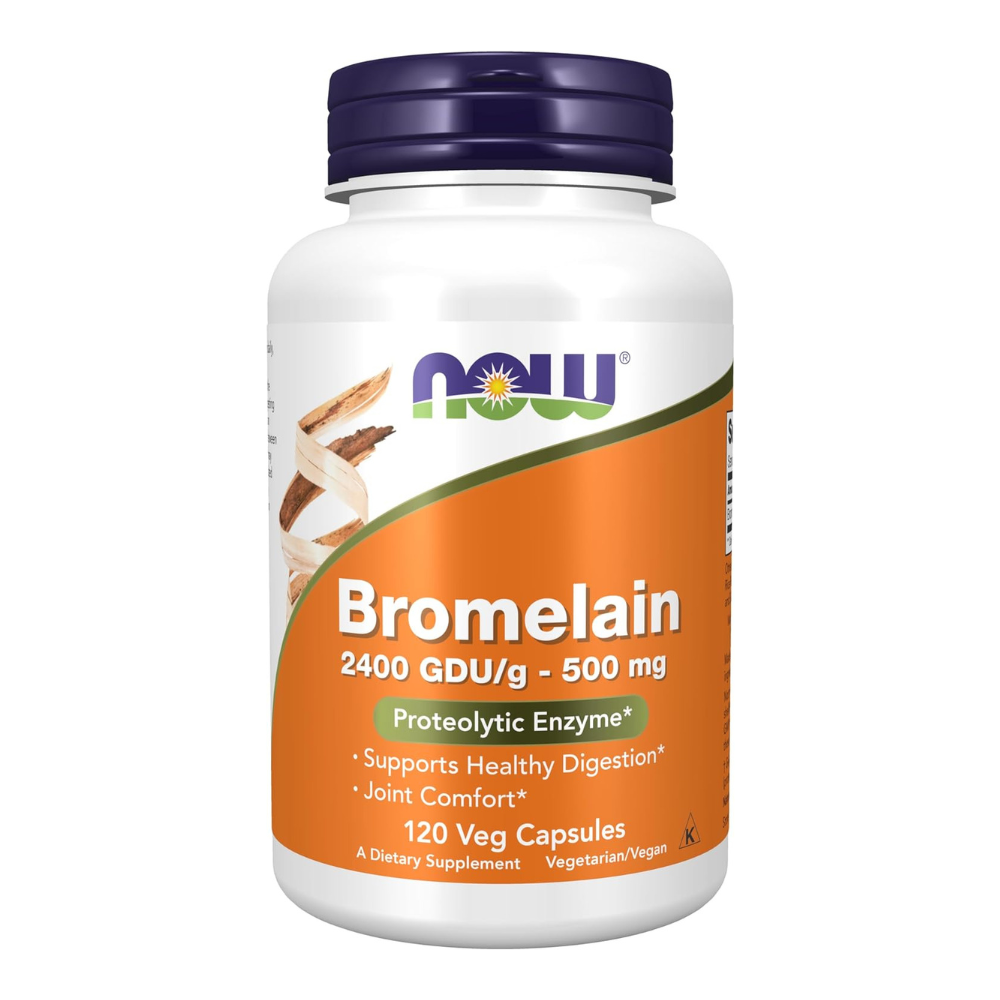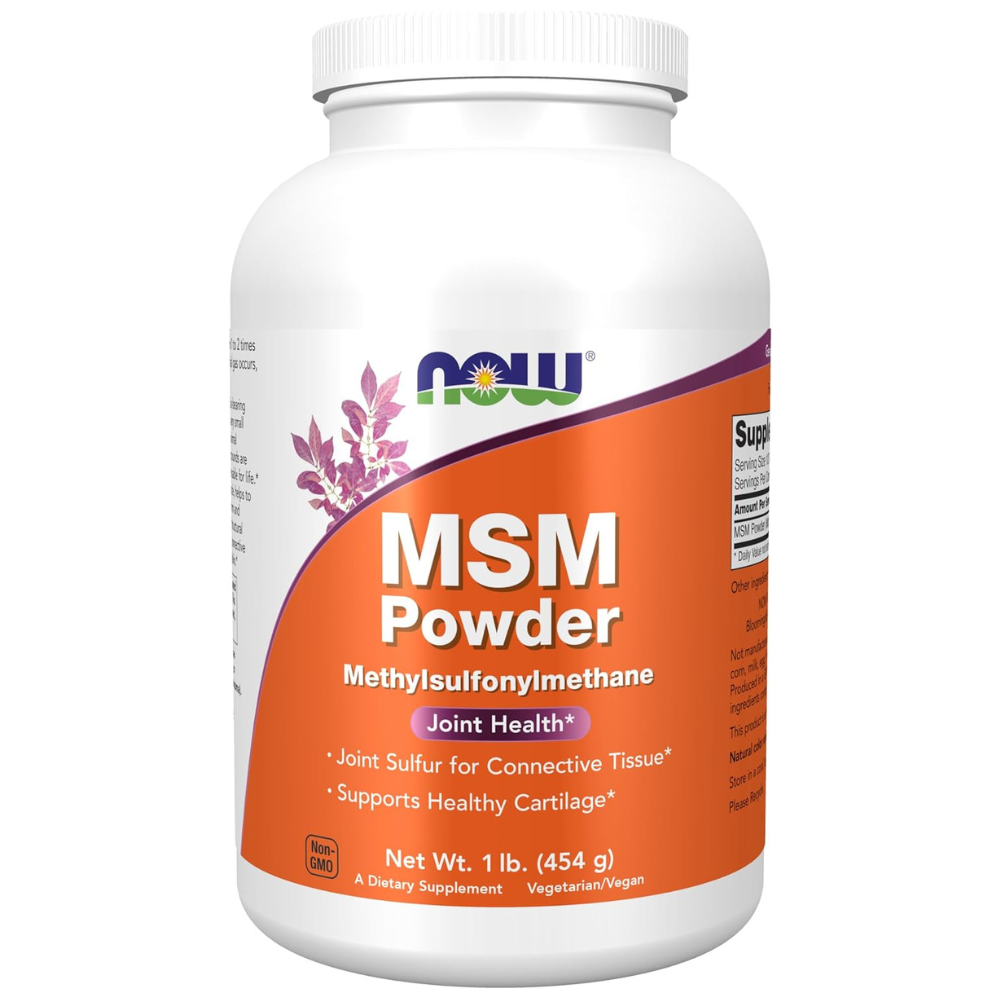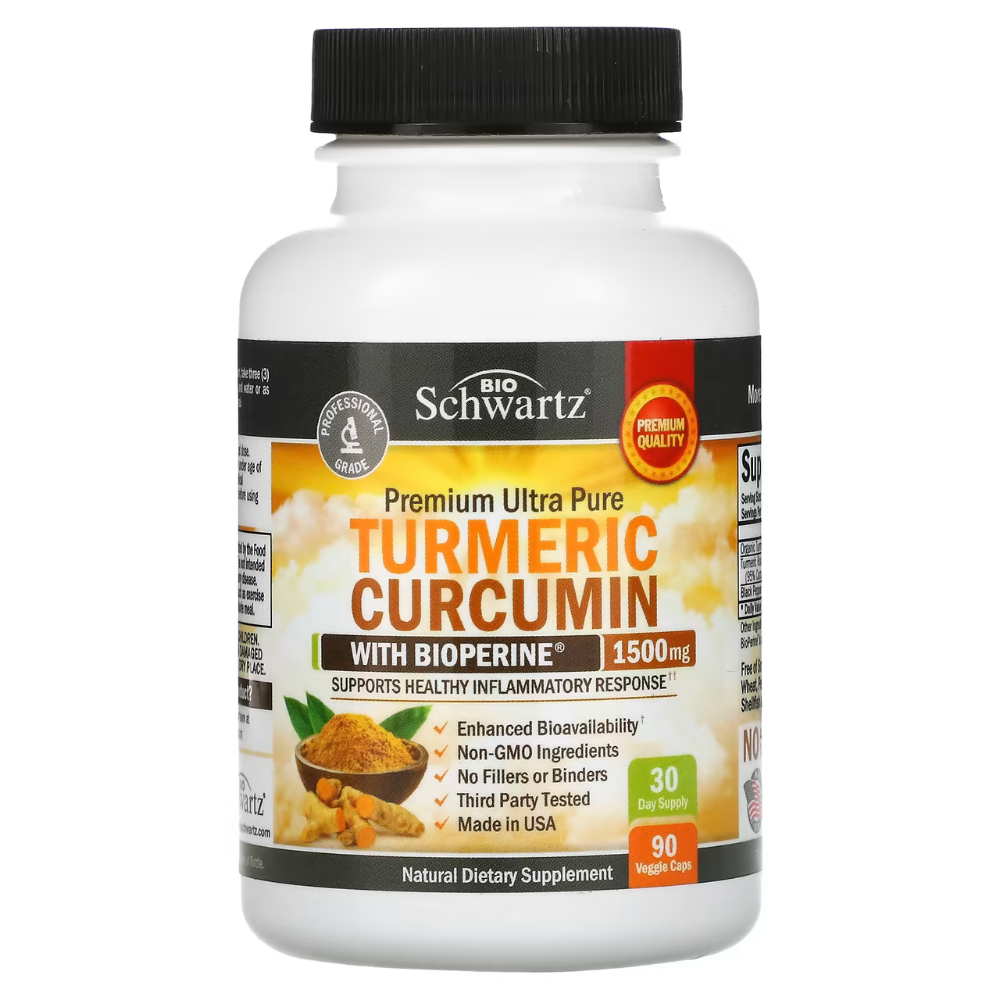The Best Supplements For Menopause Joint Pain: A Product Review

Ladies, are you experiencing joint pain during menopause?
As women, we all know that menopause can bring on a host of physical and emotional changes. But did you know that one common symptom is joint pain?
While there are prescription medications available, some prefer natural remedies to relieve their discomfort.
Say goodbye to those pesky aches and pains with our top recommended supplements for menopause joint pain. These natural options have been proven effective in providing relief so you can continue living your best life without the side effects of medication.
Don't let menopause slow you down any longer. Click this ad now and learn more about the best supplements to relieve joint pain during this phase of life.
How We Choose The Best Supplements
Finding reliable product recommendations that align with your budget and needs can be a daunting task.
Reading through countless reviews and personally testing products can still leave you unsure about their true quality. Plus, with so many supplements out there just trying to grab your money, how can you trust what's worth buying?
That's where Kiki comes in. We've done the hard work for you, sifting through thousands of reviews and personally testing products to ensure you get the best recommendations. But we didn't stop there.
Kiki has even learned how to energetically test supplements using a pendulum, giving you a clear scale of their quality from 1 to 10. So trust your friend Kiki to guide you towards products that truly deliver on their promises.

Bromelain By NOW Foods

#1 Best Supplement For Menopause Joint Pain
Bromelain By NOW Foods
Energy Testing Results: 8.8/10
Why Do We Promote It
NOW Foods is a family-owned company with a unique vision. Their mission is to provide value in products and services that empower people to lead healthier lives.
They are committed to upholding the principles that have guided them from the beginning, and they strive to make a positive impact on people's lives.
Their dedication to quality, affordability, and sustainability sets them apart from other companies in their industry. They take pride in the fact that their products are made with the highest quality standards and are backed by rigorous testing and research.
Whether it's their supplements, foods, or personal care products, they aim to make a difference in people's lives through their commitment to health and wellness.
What's Good About It
Introducing Bromelain from NOW Foods - your ultimate solution for natural and effective digestion support! This powerhouse product is not just your average enzyme supplement, it's a game-changer that will revolutionize the way you approach digestive health.
Derived from the stem of the pineapple plant, Bromelain is a natural proteolytic enzyme with incredible protein-digesting properties. This means that when taken with food, it helps enhance the breakdown and absorption of proteins, ensuring that your digestion is smooth, efficient, and hassle-free.
Designed by nature itself, Bromelain is the superhero your gastrointestinal system has been longing for. It promotes proper digestive function, ensuring that your body can extract the maximum nutrients from your meals and absorb them efficiently.
But wait, there's even more! Bromelain's benefits extend beyond digestion and joint comfort. Its powerful properties also provide muscle and joint relief - a double whammy that will leave you feeling like a million bucks.
Not only is Bromelain designed to enhance your well-being, but it is also GMP Quality Assured, meaning that every step of the manufacturing process has been rigorously tested and meets the highest standards of quality, purity, and safety.
Say goodbye to sluggish digestion, discomfort, and muscle soreness. Say hello to a vibrant, healthy, and energized you. Try Bromelain from NOW Foods today, and experience the transformative power of nature in your love for your body.
MSM Powder By NOW Foods

#2 Best Supplement For Menopause Joint Pain
MSM Powder By NOW Foods
Energy Testing Results: 9.5/10
Why Do We Promote It
NOW has been committed to empowering healthy living since the beginning. The company is a family-owned brand with a rich legacy in the natural products and supplement industry.
They are a founding supporter of Vitamin Angels, an organization dedicated to the fight against malnutrition and vitamin deficiencies. The mission of NOW is to offer high-quality products that enable people to lead healthier lives.
Their commitment to superior quality involves sourcing sustainably, maintaining transparency at all levels, and using exclusive testing methods.
As a family-run company, its employees are considered their most important customers, and their focus is to provide a healthy way of life through top-of-the-line quality and unmatched value.
What's Good About It
Introducing MSM Powder from NOW Foods, the ultimate solution for your joint health and general well-being. This remarkable product is packed with Methylsulfonylmethane, or MSM, which plays a crucial role in the body's sulphur cycle, helping to create the chemical links needed to form and maintain various structural tissues.
Joint health is essential for a happy and active lifestyle, and MSM Powder has got you covered. It provides the necessary joint sulphur for your connective tissues, supporting healthy cartilage and ensuring smooth movement.
But MSM Powder doesn't stop there – it also encompasses the broader scope of general health. By incorporating MSM into your daily routine, you are providing your body with the necessary building blocks to maintain healthy skin, strong connective tissues, and overall well-being.
When you choose MSM Powder from NOW Foods, you are choosing a product that is backed by GMP Quality Assurance. We believe in providing you with the highest standards of excellence, ensuring that every scoop of MSM Powder is pure, safe, and effective.
So why wait any longer? Take charge of your joint health and general well-being with MSM Powder from NOW Foods. Its informative and trustworthy formula will keep you informed and empowered throughout your health journey.

Turmeric Curcumin By BioSchwartz

#3 Best Supplement For Menopause Joint Pain
Turmeric Curcumin By BioSchwartz
Energy Testing Results: 9.8/10
Why Do We Promote It
At Schwartz Bioresearch, they are dedicated to providing their customers with the highest quality supplements possible. They take product quality and safety very seriously, which is why they follow a strict manufacturing process that exceeds the expectations set by cGMP.
All of their supplements are made in the USA, in an FDA-approved manufacturing facility where they establish rigorous quality control standards.
They use only natural and high-grade raw ingredients that are routinely tested for purity and quality, and all of their formulas are developed using the latest technologies to ensure that they are 100% pure and natural.
Unlike most other brands, their supplements do NOT contain fillers, binders, magnesium stearate, preservatives, or chemicals – just pure, natural ingredients.
When you buy from Schwartz Bioresearch, you can be confident that you are getting a high-quality, pure supplement that will help you achieve your health and wellness goals.
What's Good About It
Unlock the secret power of nature with Turmeric Curcumin from BioSchwartz. This premium supplement is specifically designed to support a healthy inflammatory response, leaving you feeling your best. Say goodbye to discomfort and hello to a vibrant, active lifestyle!
At BioSchwartz, they are committed to providing you with the highest quality products. That's why their turmeric curcumin is allergen-free and gluten-free, ensuring everyone can experience the benefits.
They believe in transparency, so their product is lab-tested and 3rd party certified for purity and potency. Rest assured, you are getting the best of the best.
What sets their turmeric curcumin apart is the addition of BioPerine, a patented ingredient that significantly increases absorption and bioavailability. This means that you'll be able to fully reap the benefits of turmeric curcumin, making it an essential addition to any supplement routine.
They take pride in using only the purest ingredients. Their vegan, non-GMO capsules feature ultra-pure turmeric extract with an impressive 95% curcuminoid content. This means you are getting the most powerful dose without any unnecessary additives.
BioSchwartz has done all the hard work for you, ensuring you receive a premium product supporting your overall well-being. With their informative and transparent approach, you can feel confident in your decision.

Supplements For Menopause Joint Pain FAQs
Menopause can be a difficult time for many women, with various symptoms and discomforts. Joint pain is one such issue that can significantly impact daily life.
The pain and stiffness in joints can make movement uncomfortable and hinder an active lifestyle. It can limit physical activities, cause frustration, and affect overall well-being.
To help alleviate menopausal joint pain, we have compiled a list of frequently asked questions about supplements specifically designed to address this issue.
We aim to provide you with information and insights that can assist you in making informed decisions about managing and reducing joint pain during menopause.
What Vitamins Are Good For Joint Pain During Menopause?
Menopause is a natural phase of a woman's life that can bring about numerous changes, both physically and mentally. One common symptom of menopause is joint pain, which can greatly impact the daily lives of women going through this transition.
While many factors contribute to joint pain during menopause, one important aspect to consider is the role of vitamins.
Vitamins play a crucial role in maintaining overall health and well-being, and when it comes to joint pain during menopause, some specific vitamins have shown great benefits. In this answer, we will discuss the top menopause supplements and vitamins that are good for joint pain during menopause.
Vitamin D:
One of the most essential vitamins for combating joint pain during menopause is vitamin D. This vitamin helps in maintaining bone density and strength by aiding in calcium absorption. As women age and go through menopause, their estrogen levels decrease, which can lead to a decline in bone mass and increase their risk for osteoporosis.
Vitamin D has been found to reduce symptoms associated with osteoporosis such as back pain or stiffness in joints.
Vitamin K:
Another crucial vitamin to ease joint pain during menopause is vitamin K. This fat-soluble nutrient plays an important role in regulating calcium metabolism, maintaining healthy bones, and cartilage formation. Studies have shown that postmenopausal women who take adequate amounts of vitamin K experience less discomfort from knee or hip-related pains.
Vitamin C:
Vitamin C has powerful antioxidant properties that help reduce inflammation within the body's joints while also having a positive effect on collagen production- an essential component for our bones' elasticity and strength.
Furthermore, vitamin C also supports cartilage growth, reducing stiffness, and preventing damage due to free radicals. Thus, it promotes healthy joints, and its deficiency can lead to increased wear and tear on your joints causing more frequent episodes of severe agony.
Vitamin E:
Vitamin E is a potent antioxidant that helps to reduce inflammation in the body by neutralizing harmful free radicals. As we age and go through menopause, our bodies produce fewer natural antioxidants, which can result in joint pain and stiffness.
Vitamin E supplements have been found to alleviate painful joints during menopause and promote better flexibility and range of motion.
Omega-3 Fatty Acids:
Omega-3 fatty acids are essential for reducing inflammation within the joints. These healthy fats can be found in foods such as fish, nuts, and seeds. Studies have shown that incorporating omega-3s into your diet can help improve joint mobility and decrease stiffness during menopause.
In addition to these vitamins, it's also important to maintain a healthy lifestyle by exercising regularly. Low-impact exercises such as walking or swimming can help strengthen muscles around the joints and improve overall flexibility. It's also crucial to maintain a balanced diet that includes calcium-rich foods like dairy products or leafy greens.
Lastly, make sure you consult with your doctor before starting any vitamin supplements or making significant changes to your diet/exercise routine. Taking too much of certain vitamins could lead to adverse effects on your health.
In conclusion, while joint pains are common symptoms during menopause, it doesn't have to hinder your daily life.
By incorporating these essential vitamins into your routine along with proper exercise and a balanced diet, you can greatly reduce pain and continue living an active lifestyle. Remember always to prioritize self-care during this transition period as it plays a crucial role in maintaining good overall health.
What Helps Joint Pain During Menopause?
Menopause is a natural process that every woman goes through, typically between the ages of 45 and 55. While it marks the end of a woman's reproductive years, menopause can also bring about a host of physical changes, including joint pain.
Joint pain during menopause is caused by hormonal fluctuations. As estrogen levels decrease during this time, it can lead to inflammation in the joints and result in pain and discomfort. This can be exacerbated by other factors such as age-related wear and tear on the body's cartilage and bones.
But fear not! There are many effective solutions available to treat joint pain during menopause. Here are some tips that you should try:
1) Maintain a healthy diet: Consuming an anti-inflammatory diet rich in fruits, vegetables, whole grains, fish, and lean proteins can help reduce joint pain. These foods contain antioxidants that fight free radicals which cause inflammation.
2) Stay hydrated: Drinking plenty of water will not only keep your body hydrated but also lubricate your joints for smoother movement.
3) Exercise regularly: Staying active is crucial for managing joint pain during menopause. Low-impact exercises like walking or swimming can help strengthen muscles without putting too much stress on the joints.
4) Try supplements: Certain supplements like calcium, vitamin D, magnesium, glucosamine, and chondroitin have been shown to improve bone density and reduce joint pain.
5) Use heat therapy: Applying heat packs or taking warm baths can provide relief from achy joints by increasing blood flow to those areas.
6) Consider hormone replacement therapy (HRT): If lifestyle changes alone do not alleviate your joint pain symptoms, talk to your doctor about HRT options. This treatment involves replacing hormones that decrease during menopause with medication containing estrogen or progesterone which may help relieve joint discomfort.
It's important to remember that everyone experiences menopause differently so what works for one person may not work for another. It's crucial to consult with your doctor about the best treatment plan for you.
Moreover, certain lifestyle habits can worsen joint pain during menopause and should be avoided. These include smoking, excessive alcohol consumption, and a sedentary lifestyle.
In addition to these tips, it's also essential to prioritize self-care during this time. Getting enough rest and practicing relaxation techniques such as yoga or meditation can help manage stress levels which can contribute to joint pain.
It's normal to experience joint pain during menopause, but it doesn't have to stop you from living your life fully. By making some simple changes in your diet and lifestyle, staying active, and seeking proper treatment when needed, you can alleviate joint pain and continue enjoying all that life has to offer!
How Do I Know If Joint Pain Is Menopause?
The menopausal transition is a natural and inevitable phase in a woman's life that usually occurs between the ages of 45 and 55. During this time, the body goes through significant hormonal changes, leading to various physical symptoms such as hot flashes, night sweats, mood swings, and yes - joint pain.
Joint pain during menopause can be confusing for many women because it is not typically discussed or associated with this stage of life. However, research has shown that up to half of all women going through menopause will experience some form of joint pain.
So how do you know if your joint pain is related to menopause? Here are a few key indicators:
Age: As mentioned earlier, menopause usually occurs between the ages of 45-55. If you fall within this age range and are experiencing joint pain for the first time or have noticed an increase in your existing pain levels, then it could be due to menopause.
Hormonal Changes: During perimenopause (the period leading up to menopause), there is a decline in estrogen levels in the body. Estrogen plays a crucial role in maintaining bone density and promoting cartilage health. When its levels decrease during menopause, joints can become weaker and more prone to inflammation and stiffness.
Location of Pain: Menopausal joint pain tends to occur most commonly in weight-bearing joints such as knees, hips, ankles, and wrists. This type of arthritis is known as osteoarthritis - where wear and tear damages the cartilage cushioning at these joints over time.
No History Of Joint Pain: If you have never experienced any form of joint discomfort before but suddenly start noticing achy or stiff joints during your late forties or early fifties - it could be another sign pointing towards hormone-related causes rather than injury or wear-and-tear factors.
Accompanying Symptoms: Along with joint pain, women going through menopause may also experience other symptoms such as hot flashes, night sweats, sleep disturbances, and changes in mood and libido. These can all be attributed to the hormonal imbalances happening during this time.
But the good news is that there are ways to manage menopausal joint pain effectively. Here are some tips:
Stay Active: Regular physical activity can help improve joint mobility and reduce stiffness caused by arthritis. Low-impact exercises like walking, swimming, or yoga can help strengthen muscles and improve overall joint health.
Maintain a Healthy Weight: Being overweight puts extra strain on joints, especially weight-bearing ones like knees and hips. By maintaining a healthy weight through a balanced diet and regular exercise, you can minimize stress on your joints.
Try Natural Remedies: Some natural supplements like fish oil, turmeric, ginger, and glucosamine have shown promising results in reducing inflammatory joint pain associated with menopause.
Wear Comfortable Shoes: Choosing comfortable shoes that offer proper support for your feet is essential for reducing stress on weight-bearing joints.
Consider Hormone Replacement Therapy (HRT): In severe cases where menopausal symptoms are significantly impacting daily life quality - HRT may be recommended by doctors to help regulate hormone levels in the body.
To sum it up - yes; joint pain can be linked to menopause. However, if you're experiencing persistent or severe discomfort in your joints during this stage of life - visiting a healthcare professional is always advised for an accurate diagnosis and personalized treatment plan tailored to your needs.
In conclusion, "Is Joint Pain A Sign Of Menopause?" The answer is yes; it certainly can be but not necessarily in all cases!
Why Do All My Joints Hurt During Menopause?
Menopause is a natural and inevitable process in a woman's life, typically occurring between the ages of 45 to 55. During this time, the body goes through significant hormonal changes as it transitions from a reproductive to a non-reproductive state.
Along with physical and emotional symptoms like hot flashes, mood swings, and irregular periods, many women also experience joint pain.
Firstly, it's important to understand that menopause itself does not directly cause joint pain. Rather, it is a combination of factors such as hormonal changes, aging, and lifestyle choices that contribute to joint discomfort during this phase.
Let's start with hormones - estrogen in particular. Estrogen plays a crucial role in maintaining bone density and preventing inflammation within the joints. As women approach menopause, their estrogen levels drop significantly causing bone loss which can lead to conditions like osteoporosis or osteoarthritis - both of which can result in joint pain.
Moreover, declining levels of estrogen also affect collagen production which helps keep our joints lubricated and flexible. Without enough collagen supply due to decreased estrogen levels during menopause, joints become stiff leading to discomfort and pain.
Besides hormones, age also plays a major role in joint health during menopause. As we age our bodies naturally produce less synovial fluid - the fluid that surrounds our joints providing cushioning against friction between bones. This further leads to wear and tear on cartilage causing stiffness and soreness in joints.
Another key factor contributing towards joint pain during menopause is lifestyle choices such as weight gain or lack of physical activity! With hormonal fluctuations disrupting metabolism during this time, many women tend to gain weight, especially around the abdominal region leading to added pressure on already inflamed joints resulting in increased discomfort.
Similarly, sedentary lifestyle habits only make matters worse by weakening muscles surrounding one’s joints making them more susceptible to injuries thus creating an endless cycle of stiffness followed by an even greater amount of frustration!
Now here comes the good news - you don't have to suffer through menopausal joint pain! There are various ways you can alleviate your discomfort and improve the overall health of your joints.
Firstly, incorporating a healthy and balanced diet with plenty of calcium-rich foods like dairy products, leafy green vegetables, and fish can help strengthen bones and reduce inflammation in joints. Additionally, including regular exercise such as low-impact activities like swimming or yoga can also help maintain joint flexibility and strength.
Moreover, hormone replacement therapy (HRT) is a popular option for women experiencing severe menopausal symptoms. It involves taking medications that mimic the effects of estrogen helping to alleviate bone loss and joint pain.
In case of more severe cases where lifestyle changes are not enough to provide relief, over-the-counter pain relievers such as ibuprofen or acetaminophen may be recommended by your doctor. However, it's important to consult with a medical professional before taking any medication.
In conclusion, while menopause may bring about several physical changes in our bodies including joint pain - it doesn't have to be something we just accept as part of aging.
By understanding the causes behind joint discomfort during this phase and implementing positive lifestyle choices we can effectively manage our menopause symptoms and enjoy a healthy life beyond menopause! So stay active, eat well, and seek medical advice if necessary - because after all age is just a number!
What Is The Most Common Joint Pain During Menopause?
Menopause is a natural transition in a woman's life, marking the end of her reproductive years. While many women associate menopause with hot flashes and mood swings, it can also bring about various physical changes, including joint pain.
The most common type of joint pain experienced during menopause is osteoarthritis. This is a degenerative condition that affects the cartilage in our joints, causing them to become stiff and painful. During menopause, estrogen levels decrease significantly, which can lead to inflammation and damage to the cartilage.
Furthermore, as we age our bodies produce less collagen and other proteins that help maintain the strength and elasticity of our joints. This makes us more susceptible to developing osteoarthritis during menopause.
Another contributing factor to joint pain during this time is weight gain. Many women may experience weight gain due to hormonal changes and decreased metabolism during menopause. The extra weight puts added pressure on already weakened joints, leading to increased pain and discomfort.
Apart from osteoarthritis, another common cause of joint pain during menopause is rheumatoid arthritis (RA). Unlike osteoarthritis which affects primarily older individuals, RA can occur at any age but tends to peak around ages 50-60 - aligning with the onset of menopausal symptoms in many women.
RA occurs when the immune system mistakenly attacks healthy tissues in the body - specifically targeting joints resulting in inflammation and swelling.
Women who have a history of RA or other autoimmune diseases are at an increased risk for developing RA during menopause due to hormone fluctuations impacting their immune function.
Other potential causes of joint pain experienced by women going through menopause include fibromyalgia (a disorder characterized by widespread muscle pain), gout (a type of arthritis caused by uric acid buildup), bursitis (inflammation surrounding bursae sacs located near major joints) or tendinitis (inflammation or irritation of a tendon).
If you are experiencing joint pain during menopause, there are various treatment options available to help alleviate your symptoms. Nonsteroidal anti-inflammatory drugs (NSAIDs) can provide temporary relief from pain and inflammation.
Physical therapy, exercise, and lifestyle modifications such as maintaining a healthy weight can also help manage joint pain.
Hormone replacement therapy (HRT) has also been shown to have a positive effect on joint pain in some menopausal women. As estrogen levels decline during menopause, HRT provides synthetic hormones to the body that can help prevent bone loss and reduce inflammation in the joints.
In conclusion, while hot flashes and mood swings may be the more commonly talked about symptoms of menopause, joint pain is also prevalent among women going through this natural transition.
It is essential to consult with your doctor if you are experiencing persistent or severe joint pain during menopause as it could be an indication of an underlying condition that requires medical treatment. Remember that taking care of yourself during this time is crucial for maintaining overall health and well-being.
Does Menopause Cause Arthritis?
Menopause and arthritis are two distinct medical conditions, but they can both significantly impact a woman's overall health and well-being. While menopause is a natural stage in a woman's life that marks the end of her reproductive years, arthritis is a chronic inflammatory disease that affects the joints.
Firstly, let's understand what menopause is. It typically occurs between the ages of 45-55, and it signifies the end of menstruation for women. During this time, there is a significant decrease in estrogen production by the ovaries, leading to various physical and emotional changes.
Now, arthritis - refers to inflammation of one or more joints in the body. It can be caused by various factors such as age, genetics, obesity, injuries, or infections. There are over 100 different types of arthritis; however, the most common type among women is osteoarthritis which usually affects weight-bearing joints like hips and knees.
So how are menopause and arthritis related? Well, studies have shown that hormonal changes during menopause may contribute to an increased risk of developing certain types of arthritis like rheumatoid arthritis (RA).
RA is an autoimmune disorder where the body's immune system attacks its tissues causing joint inflammation and pain.
The exact link between hormones and RA development is still not fully understood; however, research suggests that estrogen plays a crucial role in modulating immunity in women.
Hence, a sudden drop in estrogen levels during menopause may lead to weakening immune systems making them prone to autoimmune disorders like RA.
Moreover, studies have also found that women who experience early-onset menopause before reaching their 45th birthday may be at higher risk for developing osteoarthritis later on. This could be due to decreased bone density after early onset menopause leading to weaker joints more susceptible to wear-and-tear damage.
But does this mean all women will develop arthritis during or after going through menopause? Not! While hormonal changes may contribute to arthritis development, it is not the sole cause. Factors such as age, genetics, and lifestyle choices also play a significant role.
So what can women do to reduce their risk of developing arthritis during or after menopause? Firstly, maintaining a healthy weight through proper nutrition and regular exercise can help prevent osteoarthritis. Secondly, staying physically active can improve joint mobility and flexibility, preventing stiffness and discomfort.
Moreover, in some cases, hormone replacement therapy (HRT) may be prescribed by doctors to alleviate menopausal symptoms like hot flashes and night sweats. However, it's essential to consult with a healthcare professional before considering HRT as it may come with potential risks and side effects.
In conclusion, while menopause does not directly cause arthritis in women, the hormonal changes that occur during this phase of life may increase the risk of developing certain types of arthritis.
Therefore, it's crucial for women approaching menopause or entering into it to undergo regular health check-ups and adopt a healthy lifestyle to reduce their chances of developing any chronic diseases including arthritis. Remember - prevention is always better than cure!
Which Is Better For Joint Pain Collagen Or Glucosamine?
Joint pain is a common issue that affects millions of people worldwide, and finding the right solution can be overwhelming. Two popular supplements often recommended for joint pain are collagen and glucosamine.
Both have their unique benefits, but which one is better? Let's dive into the science behind these supplements to determine which is more effective for joint pain relief.
Firstly, let's understand what collagen and glucosamine are. Collagen is a protein found in our body that provides strength and support to our bones, joints, ligaments, and tendons. It acts as the building block for connective tissues in our body and is essential for maintaining healthy joints.
On the other hand, glucosamine is a natural compound present in our cartilage that helps in building new cartilage tissue.
Now coming to their role in managing joint pain - both collagen and glucosamine play crucial roles but through different mechanisms. Collagen helps in maintaining healthy cartilage by providing structural support while also reducing inflammation.
As we age, our body produces less collagen resulting in weaker cartilage leading to joint stiffness and discomfort. Therefore supplementing with collagen can help improve mobility and reduce joint pain associated with conditions such as osteoarthritis.
On the other hand, glucosamine plays a vital role in rebuilding damaged cartilage by stimulating cells responsible for producing new connective tissue. It also has anti-inflammatory properties that help reduce swelling around the joints resulting from arthritis or injury.
So now we come down to the ultimate question - which one should you choose? The answer lies somewhere between your specific needs, individual response to each supplement, and medical advice if required.
Collagen might be more beneficial for individuals looking to prevent further damage or those with mild joint discomfort due to its ability to provide structural support while reducing inflammation.
Glucosamine could be an excellent option for those experiencing severe joint pain due to its ability to regenerate damaged tissue.
However, for maximum joint health benefits, combining both collagen and glucosamine can be a winning combination. This is because they have complementary mechanisms of action and can work together to provide comprehensive support to your joints.
It's important to mention that while these supplements have shown promising results in managing joint pain, they are not a quick-fix solution. It takes time for them to show their full effect, so be patient and consistent with their intake.
Moreover, it's crucial to choose high-quality supplements from reputable brands as the supplement industry is not well-regulated. Look for supplements that are third-party tested and have good customer reviews. Also, consult with your healthcare provider before starting any new supplement regimen.
In conclusion, both collagen and glucosamine have their unique roles in maintaining healthy joints and reducing joint pain. Depending on your specific needs, you can choose one or combine them for better results.
Remember to be patient and consistent with your intake while also prioritizing quality when choosing a supplement brand. With the right approach, you can find relief from joint pain and improve your overall joint health significantly.
Will Menopause Joint Pain Go Away?
Menopause is a natural transition that marks the end of menstruation and fertility in women. Along with this change, many women experience a variety of symptoms, one of which is joint pain. This can be a frustrating and uncomfortable aspect of menopause, but the good news is that there are ways to manage and potentially alleviate this symptom.
Firstly, it's important to understand why menopause can cause joint pain in the first place. During menopause, there is a decrease in estrogen levels, which plays a key role in inflammation regulation. With lower levels of estrogen, there may be an increase in inflammation throughout the body, leading to joint pain or stiffness.
But do not fear - there are multiple methods for managing this discomfort during menopause! One solution is hormone replacement therapy (HRT), which involves replacing estrogen through medication. This can help restore hormonal balance and reduce joint pain caused by decreased estrogen levels.
Another way to combat joint pain during menopause is through regular exercise. Exercise has been shown to improve flexibility and mobility while also reducing inflammation in joints. Low-impact exercises such as swimming or yoga are great options for those experiencing joint pain.
In addition to HRT and exercise, making dietary changes can also contribute greatly towards reducing joint pain during menopause. Consuming foods rich in antioxidants like fruits and vegetables can help reduce overall inflammation levels in the body.
Additionally, adding calcium-rich foods such as dairy products or leafy greens into your diet can help strengthen bones affected by hormonal changes during menopause.
Furthermore, incorporating supplements such as omega-3 fatty acids or vitamin D into your routine may also provide relief from joint discomfort caused by decreased estrogen levels.
It's important to acknowledge that every woman experiences menopause differently - what may work for someone else may not necessarily work for you. It's always best to consult with your doctor before starting any new treatment plan or medication.
Lastly, practicing self-care techniques such as massages, hot or cold compresses, and relaxation techniques can also aid in managing joint pain during menopause.
In conclusion, while menopause-related joint pain may be a common and frustrating symptom for many women, it is not something that you have to suffer through. By incorporating a combination of treatments such as HRT, exercise, dietary changes, supplements, and self-care practices into your lifestyle, you can effectively manage and potentially alleviate the discomfort caused by this transitional phase.
Remember to always prioritize your health and well-being during this time - after all, menopause may signify the end of one chapter but it also marks the beginning of another exciting journey. So embrace this change with open arms and take care of yourself!
Can Menopause Cause Neck And Shoulder Pain?
Menopause, the natural process that marks the end of reproductive years in women, is well-known for causing various physical and emotional changes.
While hot flashes, mood swings, and weight gain are commonly associated with menopause, many women also experience neck and shoulder pain as a result of hormonal fluctuations.
During menopause, the body's production of estrogen decreases significantly. Estrogen plays a crucial role in maintaining bone health by regulating calcium absorption. With lower levels of estrogen, bones become weaker and more prone to inflammation and pain.
The neck and shoulder joints are particularly susceptible to this due to their complex structure and heavy use throughout our lives.
Additionally, during menopause, there is an increase in the production of inflammatory chemicals called cytokines which can contribute to overall body pain. These chemicals also cause joint inflammation leading to stiffness and discomfort in the neck and shoulders.
Another factor that can contribute to neck and shoulder pain during menopause is muscle tension caused by stress or anxiety. As hormones fluctuate drastically during this time, it can lead to increased feelings of anxiety or depression which can manifest physically as tightness in muscles around the neck area.
It is important for women going through menopause to address any significant changes they may be experiencing with their healthcare provider. Neck or shoulder pain should not be ignored as it could be indicative of underlying issues such as arthritis or osteoporosis.
A proper diagnosis will enable your doctor to provide targeted treatment options such as hormone therapy or non-hormonal medications like ibuprofen for relief from symptoms.
In addition to medical treatments, several lifestyle modifications can help alleviate neck and shoulder pain during menopause:
1) Regular exercise: This helps strengthen muscles surrounding your spine which provides support for your neck.
2) Proper posture: Maintaining good posture while sitting or standing reduces strain on your shoulders.
3) Heat therapy: Applying heat pads relaxes tense muscles providing relief from pain.
4) Yoga or stretching: Engaging in gentle stretching exercises like yoga can help improve flexibility and decrease muscle stiffness.
5) Meditation and relaxation techniques: Managing stress through meditation, deep breathing, or other relaxation techniques can also relieve muscle tension.
In conclusion, menopause is a natural phase of life that brings about various physical changes. Neck and shoulder pain are common symptoms experienced by women during this time due to hormonal fluctuations, inflammation, and muscle tension.
Seeking proper medical advice and making lifestyle modifications can help alleviate these symptoms and make the transition through menopause easier. Remember to listen to your body and prioritize self-care during this time for a smoother journey towards wellness.
Is Turmeric Good For Menopause Joint Pain?
Turmeric, commonly known as the "golden spice", has been used for centuries in traditional medicine to treat a variety of ailments. With its bright yellow color and distinct flavor, turmeric is not only a staple in cooking but also a powerful medicinal herb.
One of its many potential benefits is its ability to alleviate joint pain, making it an excellent natural remedy for menopausal women.
Menopause is a natural process that occurs in women between the ages of 45-55, marking the end of their reproductive years. It can bring about a host of discomforts such as hot flashes, mood swings, and joint pain. Joint pain during menopause is often caused by hormonal imbalances and inflammation in the body.
So how does turmeric help with menopausal joint pain? Let's delve into the scientific evidence behind this wonder spice.
Firstly, turmeric contains an active compound called curcumin which has powerful anti-inflammatory properties. Studies have shown that curcumin can effectively reduce inflammation in the body by blocking certain enzymes responsible for triggering it.
This makes turmeric an ideal natural treatment for managing joint pain associated with menopause.
But that's not all – research has also revealed that curcumin acts as a potent antioxidant. Antioxidants are crucial for preventing cell damage caused by free radicals and reducing oxidative stress.
Inflammation triggers oxidative stress which leads to degeneration of tissues and joints – causing more pain and discomfort during menopause. By neutralizing these harmful free radicals, turmeric helps protect our joints from further damage.
Moreover, several clinical trials have demonstrated the effectiveness of turmeric in improving symptoms associated with arthritis – another common cause of joint pain during menopause. This further underscores its potential as a natural solution for managing joint discomforts brought on by hormonal changes.
Not only can turmeric provide relief from physical symptoms but it may also positively impact mental health during menopause. Studies have shown that curcumin can enhance brain function by increasing levels of a hormone called BDNF (Brain-Derived Neurotrophic Factor).
Low levels of this hormone have been linked to depression, which is commonly experienced during menopause. By boosting BDNF, turmeric may help alleviate mood swings and improve overall well-being.
But before you rush to your nearest supermarket to stock up on turmeric powder, it's essential to keep a few things in mind. The amount of curcumin in turmeric is relatively low – only about 3% by weight.
This means that simply adding a pinch or two of turmeric to your meals won't provide enough curcumin for therapeutic benefits. To experience the full potential of this spice, it's best to consume it in supplement form with standardized amounts of curcumin.
That being said, incorporating turmeric into your diet has numerous other health benefits apart from joint pain relief. It has antibacterial and antifungal properties which help boost immunity and fight off infections.
Additionally, studies suggest that regular consumption of turmeric may even lower the risk of chronic diseases such as heart disease and cancer.
In conclusion, while there is no cure for menopausal joint pain, incorporating turmeric into our daily routine can be highly beneficial for managing its discomforts.
This spice not only provides potent anti-inflammatory effects but also protects our joints from further damage through its antioxidant properties – making it an invaluable natural remedy for women going through menopause.
Best Supplements For Menopause Joint Pain For You
In conclusion, we understand that joint pain during menopause can be a frustrating and debilitating experience for many women. That's why we at Kiki put in the time and effort to carefully research and test various supplements to find the best ones for managing this common symptom.
After a thorough examination, it is clear that our top recommended supplements stand out above the rest in terms of quality, effectiveness, and safety. By incorporating these supplements into your daily routine, you can alleviate your menopausal joint pain and continue living your life to the fullest without being held back by discomfort.
We hope that our findings will help guide you in making informed decisions when it comes to finding relief from menopause joint pain. Remember, always consult with your healthcare provider before starting any new supplement regimen to ensure compatibility with your health needs.
Thank you for trusting us to provide you with reliable information, and here's to a more comfortable and active menopausal journey!
Healthfully,
Kiki And His Team





